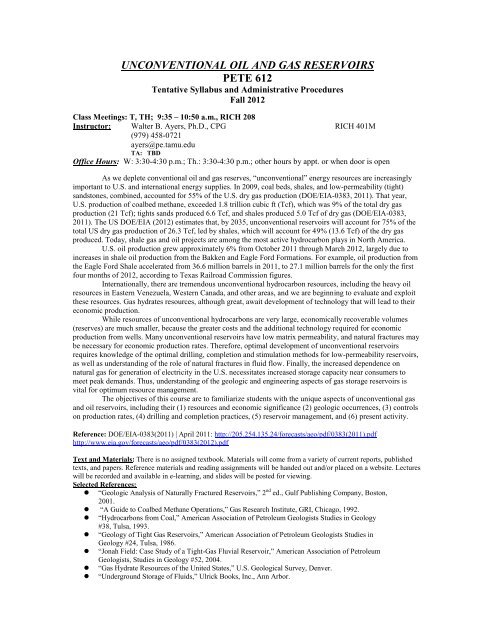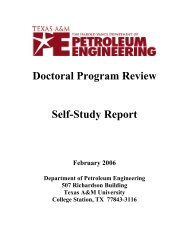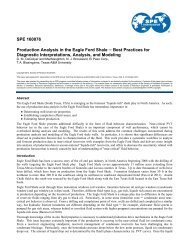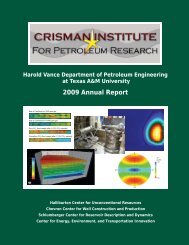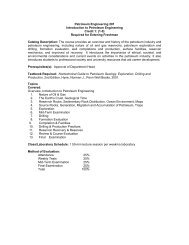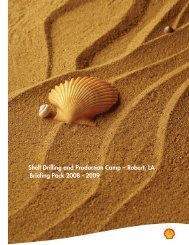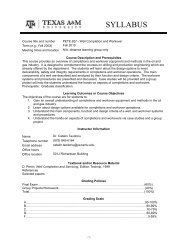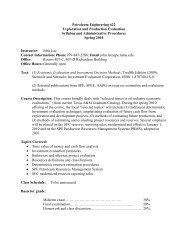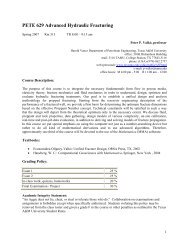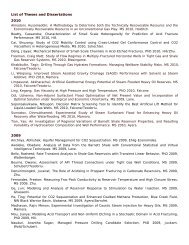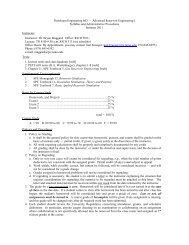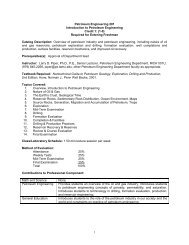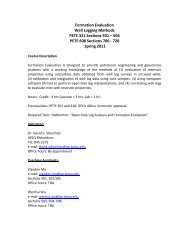PETE 612 Unconventional Oil and Gas Reservoirs - Texas A&M ...
PETE 612 Unconventional Oil and Gas Reservoirs - Texas A&M ...
PETE 612 Unconventional Oil and Gas Reservoirs - Texas A&M ...
Create successful ePaper yourself
Turn your PDF publications into a flip-book with our unique Google optimized e-Paper software.
UNCONVENTIONAL OIL AND GAS RESERVOIRS<br />
<strong>PETE</strong> <strong>612</strong><br />
Tentative Syllabus <strong>and</strong> Administrative Procedures<br />
Fall 2012<br />
Class Meetings: T, TH; 9:35 – 10:50 a.m., RICH 208<br />
Instructor: Walter B. Ayers, Ph.D., CPG RICH 401M<br />
(979) 458-0721<br />
ayers@pe.tamu.edu<br />
TA: TBD<br />
Office Hours: W: 3:30-4:30 p.m.; Th.: 3:30-4:30 p.m.; other hours by appt. or when door is open<br />
As we deplete conventional oil <strong>and</strong> gas reserves, “unconventional” energy resources are increasingly<br />
important to U.S. <strong>and</strong> international energy supplies. In 2009, coal beds, shales, <strong>and</strong> low-permeability (tight)<br />
s<strong>and</strong>stones, combined, accounted for 55% of the U.S. dry gas production (DOE/EIA-0383, 2011). That year,<br />
U.S. production of coalbed methane, exceeded 1.8 trillion cubic ft (Tcf), which was 9% of the total dry gas<br />
production (21 Tcf); tights s<strong>and</strong>s produced 6.6 Tcf, <strong>and</strong> shales produced 5.0 Tcf of dry gas (DOE/EIA-0383,<br />
2011). The US DOE/EIA (2012) estimates that, by 2035, unconventional reservoirs will account for 75% of the<br />
total US dry gas production of 26.3 Tcf, led by shales, which will account for 49% (13.6 Tcf) of the dry gas<br />
produced. Today, shale gas <strong>and</strong> oil projects are among the most active hydrocarbon plays in North America.<br />
U.S. oil production grew approximately 6% from October 2011 through March 2012, largely due to<br />
increases in shale oil production from the Bakken <strong>and</strong> Eagle Ford Formations. For example, oil production from<br />
the Eagle Ford Shale accelerated from 36.6 million barrels in 2011, to 27.1 million barrels for the only the first<br />
four months of 2012, according to <strong>Texas</strong> Railroad Commission figures.<br />
Internationally, there are tremendous unconventional hydrocarbon resources, including the heavy oil<br />
resources in Eastern Venezuela, Western Canada, <strong>and</strong> other areas, <strong>and</strong> we are beginning to evaluate <strong>and</strong> exploit<br />
these resources. <strong>Gas</strong> hydrates resources, although great, await development of technology that will lead to their<br />
economic production.<br />
While resources of unconventional hydrocarbons are very large, economically recoverable volumes<br />
(reserves) are much smaller, because the greater costs <strong>and</strong> the additional technology required for economic<br />
production from wells. Many unconventional reservoirs have low matrix permeability, <strong>and</strong> natural fractures may<br />
be necessary for economic production rates. Therefore, optimal development of unconventional reservoirs<br />
requires knowledge of the optimal drilling, completion <strong>and</strong> stimulation methods for low-permeability reservoirs,<br />
as well as underst<strong>and</strong>ing of the role of natural fractures in fluid flow. Finally, the increased dependence on<br />
natural gas for generation of electricity in the U.S. necessitates increased storage capacity near consumers to<br />
meet peak dem<strong>and</strong>s. Thus, underst<strong>and</strong>ing of the geologic <strong>and</strong> engineering aspects of gas storage reservoirs is<br />
vital for optimum resource management.<br />
The objectives of this course are to familiarize students with the unique aspects of unconventional gas<br />
<strong>and</strong> oil reservoirs, including their (1) resources <strong>and</strong> economic significance (2) geologic occurrences, (3) controls<br />
on production rates, (4) drilling <strong>and</strong> completion practices, (5) reservoir management, <strong>and</strong> (6) present activity.<br />
Reference: DOE/EIA-0383(2011) | April 2011: http://205.254.135.24/forecasts/aeo/pdf/0383(2011).pdf<br />
http://www.eia.gov/forecasts/aeo/pdf/0383(2012).pdf<br />
Text <strong>and</strong> Materials: There is no assigned textbook. Materials will come from a variety of current reports, published<br />
texts, <strong>and</strong> papers. Reference materials <strong>and</strong> reading assignments will be h<strong>and</strong>ed out <strong>and</strong>/or placed on a website. Lectures<br />
will be recorded <strong>and</strong> available in e-learning, <strong>and</strong> slides will be posted for viewing.<br />
Selected References:<br />
• “Geologic Analysis of Naturally Fractured <strong>Reservoirs</strong>,” 2 nd ed., Gulf Publishing Company, Boston,<br />
2001.<br />
• “A Guide to Coalbed Methane Operations,” <strong>Gas</strong> Research Institute, GRI, Chicago, 1992.<br />
• “Hydrocarbons from Coal,” American Association of Petroleum Geologists Studies in Geology<br />
#38, Tulsa, 1993.<br />
• “Geology of Tight <strong>Gas</strong> <strong>Reservoirs</strong>,” American Association of Petroleum Geologists Studies in<br />
Geology #24, Tulsa, 1986.<br />
• “Jonah Field: Case Study of a Tight-<strong>Gas</strong> Fluvial Reservoir,” American Association of Petroleum<br />
Geologists, Studies in Geology #52, 2004.<br />
• “<strong>Gas</strong> Hydrate Resources of the United States,” U.S. Geological Survey, Denver.<br />
• “Underground Storage of Fluids,” Ulrick Books, Inc., Ann Arbor.
UNCONVENTIONAL OIL AND GAS RESERVOIRS<br />
Petroleum Engineering <strong>612</strong><br />
Syllabus <strong>and</strong> Administrative Procedures<br />
Fall 2012<br />
Basis for Grades:<br />
Homework <strong>and</strong> Report (includes, peer evaluations) ...................................... 25 percent<br />
Homework <strong>and</strong> Quizzes ................................................................................. 25 percent<br />
Midterm Examination (Oct. 19 – 22); online ................................................ 25 percent<br />
Final Examination (Friday, Dec. 7, 12:30 – 2:30 p.m.) (<strong>and</strong> online) ............. 22 percent<br />
Participation .................................................................................................. 3 percent<br />
Total = 100 percent<br />
Grade Cutoffs: (Percentages)<br />
A: ≥ 90 B: 89.99 to 80 C: 79.99 to 70 D: 69.99 to 60 F: ≤ 59.99<br />
Student Papers <strong>and</strong> (GUIDELINES – SUBJECT TO REVISION)<br />
Working in teams, students will write reports on topics related to unconventional<br />
resource occurrences <strong>and</strong> development. Topics will be assigned by 20 September, <strong>and</strong><br />
preliminary outlines <strong>and</strong> references are due 11 October. You will be given general outlines<br />
(guidelines) of topic to be covered. Reports will be submitted in both paper <strong>and</strong> digital<br />
formats, following either SPE or AAPG publication guidelines. Text of reports will be 15-20<br />
double-spaced pages; tables <strong>and</strong> figures may be either embedded in the text or placed at the end,<br />
following the references. Use EndNote software for references. Reference papers used to<br />
prepare reports will be submitted as pdf files embedded in EndNote. All reports will be due<br />
by 5 p.m. on 4 December. Peer reviews will be submitted when you submit the reports. Also,<br />
reports will be posted on the share drive <strong>and</strong> will be available to all class members. Finally, as a<br />
homework assignment, each team will submit a “Class Exercise” pertinent to their research<br />
topic.<br />
Policies <strong>and</strong> Procedures<br />
1. Students are expected to attend every class.<br />
2. All work shall be done in a professional manner; work shall be as complete as possible.<br />
3. Policy on Grading<br />
a. Homework <strong>and</strong> exams will be graded on the basis of answers only — partial credit, if<br />
given, is given solely at the discretion of the instructor.<br />
b. All work requiring calculations shall be properly <strong>and</strong> completely documented for<br />
credit.<br />
c. All grading shall be done by the instructor, or under his direction <strong>and</strong> supervision,<br />
<strong>and</strong> the decision of the instructor is final.<br />
2
UNCONVENTIONAL OIL AND GAS RESERVOIRS<br />
Petroleum Engineering <strong>612</strong><br />
Syllabus <strong>and</strong> Administrative Procedures<br />
Fall 2012<br />
4. Policy on Regrading<br />
a. Only in very rare cases will work be considered for regrading; e.g., when the total<br />
number of points deducted is not consistent with the assigned grade. Partial credit (if<br />
any) is not subject to appeal.<br />
b. Work that, while correct, cannot be followed, will be considered incorrect <strong>and</strong> will<br />
not be considered for a grade change.<br />
5. The grade for a late assignment is zero. Homework will be considered late if it is not<br />
turned in at the start of class on the due date. Late or not, all assignments must be turned<br />
in. A course grade of Incomplete will be given if any assignment is missing, <strong>and</strong> this<br />
grade will be changed only after all required work has been submitted.<br />
6. Each student should review the University Regulations concerning attendance, grades,<br />
<strong>and</strong> scholastic dishonesty. Anyone caught cheating on an examination or collaborating<br />
on an assignment where collaboration is not specifically allowed may be removed from<br />
the class roster <strong>and</strong> given an F (failure grade) in the course.<br />
Course Description<br />
Primary responsibility for the review topics will lie with the student. Recorded lectures <strong>and</strong> slides<br />
covering these topics will be posted for your review.<br />
1. Introduction to <strong>Unconventional</strong> Energy Resources<br />
What are unconventional resources?<br />
Where do they occur?<br />
Economic significance of each<br />
Technical, economic, political, <strong>and</strong> environmental constraints on development<br />
2. Petroleum Systems (review)<br />
Systematic approaches to resource assessment<br />
Hydrocarbon origin<br />
Hydrocarbon migration<br />
Hydrocarbon entrapment<br />
3. Natural Fractures (review)<br />
Importance in unconventional reservoirs<br />
Origin, occurrence, <strong>and</strong> predictability<br />
Fracture effects on HC storage, porosity, <strong>and</strong> permeability<br />
o Permeability anisotropy<br />
o Coning<br />
o Breakthrough<br />
o Boundaries<br />
Roles in exploration<br />
Roles in reservoir management - primary <strong>and</strong> enhanced recovery<br />
In-situ stress - importance in unconventional reservoir performance<br />
Classification of fractured reservoirs<br />
3
UNCONVENTIONAL OIL AND GAS RESERVOIRS<br />
Petroleum Engineering <strong>612</strong><br />
Syllabus <strong>and</strong> Administrative Procedures<br />
Fall 2012<br />
Low-permeability (Tight) S<strong>and</strong>s<br />
Occurrences, hydrocarbon origins, resources, explor. methods, reservoir characteristics<br />
Drilling, completion, <strong>and</strong> stimulation methods<br />
Facilities, reservoir management, limitations on development, present activity<br />
Coalbed <strong>Gas</strong><br />
Occurrences, hydrocarbon origins, resources, explor. methods, reservoir characteristics<br />
Drilling, completion, <strong>and</strong> stimulation methods<br />
Facilities, reservoir management, limitations on development, present activity<br />
Water <strong>and</strong> environmental issues<br />
Shale <strong>Reservoirs</strong> (<strong>Gas</strong> <strong>and</strong> <strong>Oil</strong>)<br />
Occurrences, hydrocarbon origins, resources, explor. methods, reservoir characteristics<br />
Drilling, completion, <strong>and</strong> stimulation methods<br />
Facilities, reservoir management, limitations on development, present activity<br />
Water <strong>and</strong> environmental issues<br />
<strong>Gas</strong> Hydrates<br />
Occurrences, hydrocarbon origins, resources, explor. methods, reservoir characteristics<br />
Recovery methods<br />
Limitations on development, present activity<br />
Environmental issues<br />
Heavy <strong>Oil</strong><br />
Occurrences, hydrocarbon origins, resources, explor. methods, reservoir characteristics<br />
Drilling, completion, <strong>and</strong> stimulation methods<br />
Facilities, reservoir management, limitations on development, present activity<br />
Environmental issues<br />
<strong>Gas</strong> Storage (Depending on Available Time)<br />
Types <strong>and</strong> locations of gas storage reservoirs<br />
Technical issues <strong>and</strong> terminology<br />
<strong>Gas</strong> storage volumes <strong>and</strong> economics<br />
Other <strong>Unconventional</strong> Energy Resources <strong>and</strong> Issues That May be Addressed<br />
Geothermal Energy<br />
Coal<br />
o Conversion to gas<br />
o In-situ gasification<br />
4
UNCONVENTIONAL OIL AND GAS RESERVOIRS<br />
Petroleum Engineering <strong>612</strong><br />
Syllabus <strong>and</strong> Administrative Procedures<br />
Fall 2012<br />
Americans with Disabilities Act (ADA) Policy Statement<br />
The Americans with Disabilities Act (ADA) is a federal anti-discrimination statute that<br />
provides comprehensive civil rights protection for persons with disabilities. Among other<br />
things, this legislation requires that all students with disabilities be guaranteed a learning<br />
environment that provides for reasonable accommodation of their disabilities. If you believe<br />
you have a disability requiring an accommodation, please contact the Disability Services in<br />
Room B118 of Cain Hall, or call 845-1637. For additional information visit<br />
http://disability.tamu.edu<br />
Coursework Copyright Statement (<strong>Texas</strong> A&M University Policy Statement)<br />
The h<strong>and</strong>outs used in this course are copyrighted. By "h<strong>and</strong>outs," this means all<br />
materials generated for this class, which include but are not limited to syllabi, quizzes,<br />
exams, homework, lab problems, in-class materials, review sheets, <strong>and</strong> additional<br />
problem sets. Because these materials are copyrighted, you do not have the right to<br />
copy them, unless you are expressly granted permission.<br />
As commonly defined, plagiarism consists of passing off as one’s own the ideas,<br />
words, writing, etc., that belong to another. In accordance with this definition, you are<br />
committing plagiarism if you copy the work of another person <strong>and</strong> turn it in as your<br />
own, even if you should have the permission of that person. Plagiarism is one of the<br />
worst academic sins, for the plagiarist destroys the trust among colleagues without<br />
which research cannot be safely communicated.<br />
If you have any questions about plagiarism <strong>and</strong>/or copying, please consult the latest<br />
issue of the <strong>Texas</strong> A&M University Student Rules, under the section "Scholastic<br />
Dishonesty.<br />
“Aggie Honor Code”<br />
“An Aggie does not lie, cheat, or steal or tolerate those who do.” Upon accepting<br />
admission to <strong>Texas</strong> A&M University, a student immediately assumes a commitment to<br />
uphold the Honor Code, to accept responsibility for learning <strong>and</strong> to follow the<br />
philosophy <strong>and</strong> rules of the Honor System. Students will be required to state their<br />
commitment on examinations, research papers, <strong>and</strong> other academic work. Ignorance of<br />
the rules does not exclude any member of the <strong>Texas</strong> A&M University community<br />
from the requirements or the processes of the Honor System. For additional<br />
information please visit: www.tamu.edu/aggiehonor/ On all submitted course work,<br />
assignments, <strong>and</strong> examinations in this class, recognition <strong>and</strong> acceptance of the<br />
following Honor Pledge is implicit in the student’s signature on the class materials:<br />
“On my honor, as an Aggie, I have neither given nor received unauthorized aid on<br />
this academic work.”<br />
5


